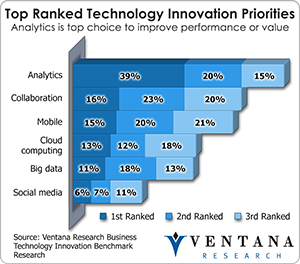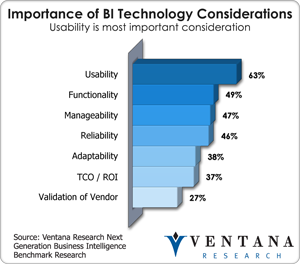QlikTech executives unveiled the future of what I cover in business analytics at its recent industry analyst summit in what they framed as natural analytics and how it underlies the company’s next major release in 2014, and with what they call QlikView.Next which they have outlined publicly. Anthony Deighton, SVP Products and Donald Farmer, VP of Product Management, did most of the talking, but it is clear that the idea unifies the business and technology strategy for its future.
In a nutshell, natural analytics is a design philosophy that taps into the human being’s innate ability for complex thinking and augments that thinking process with user-centric software. For instance, humans are very good at categorizing, detecting patterns and identifying outliers, and these abilities help us quickly process information and make decisions in environments of change and uncertainty. Natural analytics aims to complement this higher-level thinking, not replace it, with the power of technology. It is obvious that QlikTech has been thinking about this idea for a long time, and in fact the concept is consistent with the company philosophy and culture,which I assessed last year.
QlikTech is among a new generation of so-called discovery tools that enable faster and simpler exploration which empower business analysts to driveincreasingly important time-to-value (TTV) metrics. The new product release looks to leverage this legacy by putting natural analytics philosophy into practice. The product team overhauled the interface and streamlined it to work within the context of user workflows. Various workflows such as sales or operations intuitively appear on the left side of the screen as the user enters the hub, and the user can add to, change or delete them as needed. While the various workflows allow users to go into different Qlikview applications, the ability to search across the entire data set is enabled through search. The ability to search information in a dynamic fashion directly from the initial entry point helps analysts get started on their discovery journey especially when they are not sure where to start. Information discovery, as described by my colleague Mark Smith in his piece on the four types of discovery technologies, is one of the foundations of discovery and is becoming more important to organizations. Another key component of time-to-value and usability is mobility and it is another key design element of QlikView.Next. All data renders in HTML5 on the client side, which enables a responsive design based on the screen size and independent of the user platform. This strategy addresses the bring-your-own-device (BYOD) trend as well as the objective of design once and deploy anywhere. While I have not had a chance to use the product, the demo appeared responsive, with labeling and other contextual attributes appearing or disappearing based on the particular view.
The new product also has a redesigned architecture that is more modern and extensible. Incorporating QlikView Expressor, its metadata and integration technology, QlikView is targeting larger enterprise deployments with metadata, broader governance, and more advanced administration and security features. Customers may be concerned about the transition from QlikView 11 to the new architecture, but Jeff Boehm, VP of global product marketing, assured those in attendance that all data layer QVDs, scripts and models would be transferable into the new open architecture format. The company will also support QlikView 11 for another three years, which is longer than industry norms. This is a smart strategy for QlikTech since major migrations like this are often disruptive, and current customers have investments in detailed metric calculations throughout the enterprise, so there will likely still be some work to do in the transition. The extensibility of the platform facilitates partner development on the APIs, external visualizations through JavaScript APIs, integration for Windows applications through OCX extensions, and capabilities for websites and portal integration through Visual Studio plug-ins and SharePoint Web Part. Extensibility is an important element, as our research and client contacts show that customers want BI to be embedded into applications and workflows.
Collaboration is a key focus area of QlikView.Next, and the company is right to make it a priority.  Ourbenchmark research into business technology innovation shows that collaboration (across top three ranked priority in 59% of organizations) is second in importance for technology innovation only to business analytics (across top three ranked priority in 74% of organizations). The QlikView.Next builds in storytelling presentation capabilities with annotations and record selections made by users during sessions and enables navigation back and forth through previous selections. Specific points in the process can be bookmarked including annotations that can be shared with other users, thus helping communicate both the analysis and the reasoning behind it. This is another example of the natural analytics design at work that will be quite effective with business analyst and knowledge worker personas that I have outlined.
Ourbenchmark research into business technology innovation shows that collaboration (across top three ranked priority in 59% of organizations) is second in importance for technology innovation only to business analytics (across top three ranked priority in 74% of organizations). The QlikView.Next builds in storytelling presentation capabilities with annotations and record selections made by users during sessions and enables navigation back and forth through previous selections. Specific points in the process can be bookmarked including annotations that can be shared with other users, thus helping communicate both the analysis and the reasoning behind it. This is another example of the natural analytics design at work that will be quite effective with business analyst and knowledge worker personas that I have outlined.
From a business perspective, QlikTech has chosen a more revolutionary path for its next generation of technology than the evolutionary path we are seeing with others in the discovery category, such as Tibco Spotfire or Tableau. As these and competing companies move toward central IT from a distributed user-base position, their grand challenge is to balance optimizing with satisficing; the difference is also explained by Occam’s Razor. That is, deliver the complexity that is necessary but avoid putting in so much that simplicity and usability are negated. This balance for next-generation BI tools is particularly tricky as our research into next-generation business intelligence shows: For 64 percent of companies, usability is the number-one buying criterion, but functionality (49%), manageability (47%) and reliability (46%) are also important buying criteria. QlikView.Next is the first analytics discovery tool to take the bold step of trying to address this challenge head on, and I applaud the company for that.
As QlikTech moves into more of an enterprise posture, channel partnerships and how they address the specific verticals that are using their tools will become increasingly important. Currently, the company is well diversified across industries and has developed solid use cases to meet line of business needs too. It will need to apply these use cases along with partners’ consulting expertise to educate companies how Qlikview.Next fits into overall company workflows and enables better  processes and analytic collaboration. Our recent research shows that innovative technologies and new information sources are outpacing the maturity of people and the processes in organizations. If vendors cannot show how specific software supports business outcomes by enabling people and processes, they will have a tough sell.
processes and analytic collaboration. Our recent research shows that innovative technologies and new information sources are outpacing the maturity of people and the processes in organizations. If vendors cannot show how specific software supports business outcomes by enabling people and processes, they will have a tough sell.
From what I’ve seen, QlikTech’s management team understands the challenges they face with Qlikview.Next and has their eyes open to the reality of today’s enterprise business market. The company has a solid vision centered on natural analytics, and from the first look at the software, QlikNext is on track to deliver something unique and possibly disruptive. Companies looking at enterprise implementations of business intelligence managed by IT or those expanding the potential of analytics in line of business will like the innovative methods for discovery and exploration coming with QlikView.Next.
Regards,
Tony Cosentino
VP and Research Director











